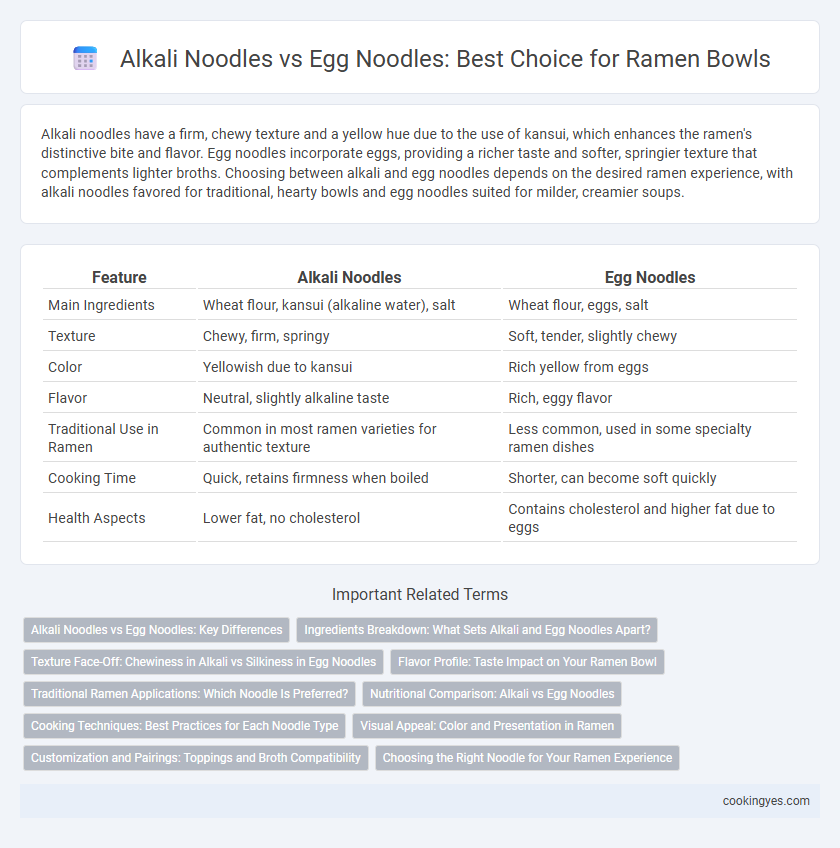Alkali noodles have a firm, chewy texture and a yellow hue due to the use of kansui, which enhances the ramen's distinctive bite and flavor. Egg noodles incorporate eggs, providing a richer taste and softer, springier texture that complements lighter broths. Choosing between alkali and egg noodles depends on the desired ramen experience, with alkali noodles favored for traditional, hearty bowls and egg noodles suited for milder, creamier soups.
Table of Comparison
| Feature | Alkali Noodles | Egg Noodles |
|---|---|---|
| Main Ingredients | Wheat flour, kansui (alkaline water), salt | Wheat flour, eggs, salt |
| Texture | Chewy, firm, springy | Soft, tender, slightly chewy |
| Color | Yellowish due to kansui | Rich yellow from eggs |
| Flavor | Neutral, slightly alkaline taste | Rich, eggy flavor |
| Traditional Use in Ramen | Common in most ramen varieties for authentic texture | Less common, used in some specialty ramen dishes |
| Cooking Time | Quick, retains firmness when boiled | Shorter, can become soft quickly |
| Health Aspects | Lower fat, no cholesterol | Contains cholesterol and higher fat due to eggs |
Alkali Noodles vs Egg Noodles: Key Differences
Alkali noodles contain kansui, an alkaline mineral water that gives them a distinct yellow hue, chewy texture, and enhanced elasticity ideal for authentic ramen. Egg noodles incorporate eggs, resulting in a richer flavor and slightly softer bite but less firmness compared to alkali noodles. The pH level difference from kansui in alkali noodles affects noodle firmness and texture, making them preferred in traditional ramen preparation.
Ingredients Breakdown: What Sets Alkali and Egg Noodles Apart?
Alkali noodles are distinguished by their use of kansui, a mixture of alkaline minerals like sodium carbonate and potassium carbonate, which gives them their firm texture and yellow hue. Egg noodles incorporate whole eggs into the dough, contributing to a richer flavor and softer bite. The key difference lies in the alkaline solution versus egg content, affecting texture, color, and flavor profile in ramen preparation.
Texture Face-Off: Chewiness in Alkali vs Silkiness in Egg Noodles
Alkali noodles feature a firm, springy chewiness due to the use of kansui, creating a resilient texture ideal for ramen. Egg noodles offer a silky, smooth mouthfeel from the incorporation of egg yolk, enhancing richness and softness in each bite. This texture contrast defines ramen experiences, with alkali noodles delivering bold resilience and egg noodles providing delicate silkiness.
Flavor Profile: Taste Impact on Your Ramen Bowl
Alkali noodles provide a chewy texture and slightly alkaline taste that enhances the savory umami flavors of ramen broth, delivering a clean and resilient bite. Egg noodles contribute a richer, buttery flavor and smoother texture, adding depth and a subtle sweetness that complements creamy or miso-based ramen. Choosing between alkali and egg noodles significantly influences the overall taste experience by balancing the noodle's flavor intensity with the broth's profile.
Traditional Ramen Applications: Which Noodle Is Preferred?
Traditional ramen recipes often favor alkaline noodles due to their firm texture and yellow hue, achieved by adding kansui, an alkaline mineral water, enhancing chewiness and flavor absorption. Egg noodles, containing eggs, provide a richer taste and softer bite but are less common in authentic ramen, which prioritizes the resilience of alkaline noodles in hot broth. For classic tonkotsu, shoyu, and miso ramen, alkaline noodles remain the preferred choice, preserving traditional taste and texture profiles.
Nutritional Comparison: Alkali vs Egg Noodles
Alkali noodles, commonly used in ramen, contain kansui, which alters their texture and gives a slightly higher sodium content compared to egg noodles. Egg noodles offer more protein and fat due to the inclusion of eggs, contributing to a richer nutritional profile. Both noodle types provide carbohydrates as a primary energy source, but alkali noodles tend to be lower in calories and fat, making them a lighter option for ramen dishes.
Cooking Techniques: Best Practices for Each Noodle Type
Alkali noodles in ramen require boiling in abundant water until tender yet firm, usually around 2-3 minutes, to maintain their characteristic chewy texture and alkaline bite. Egg noodles benefit from a shorter cooking time, approximately 1-2 minutes, to preserve their delicate structure and rich flavor imparted by the eggs. Both types should be rinsed briefly in cold water post-boiling to halt cooking and prevent stickiness, ensuring optimal texture in the finished ramen dish.
Visual Appeal: Color and Presentation in Ramen
Alkali noodles exhibit a pale yellow hue with a slightly translucent texture that enhances the broth's clarity and deepens the visual contrast in ramen bowls. Egg noodles bring a richer, golden color due to the egg content, providing a warm and inviting appearance that complements vibrant toppings. The choice between alkali and egg noodles influences the ramen's overall presentation, where alkali noodles create a delicate aesthetic, while egg noodles emphasize richness and warmth.
Customization and Pairings: Toppings and Broth Compatibility
Alkali noodles contain kansui, giving them a firmer texture and yellow hue, making them ideal for rich, soy or miso-based ramen broths that complement their elasticity. Egg noodles offer a softer bite with a richer flavor, pairing exceptionally well with lighter, chicken or shio broths that emphasize subtle, savory toppings like chashu pork or bamboo shoots. Customization often leans towards alkali noodles for ramen varieties needing a chewy contrast to dense broths, while egg noodles enhance gentle broth profiles and delicate garnishes.
Choosing the Right Noodle for Your Ramen Experience
Alkali noodles contain kansui, an alkaline mineral water that gives ramen noodles their characteristic chewiness and yellow hue, making them ideal for absorbing rich broths. Egg noodles, enriched with eggs, offer a softer texture and richer flavor but lack the springy bite typical of traditional ramen. Selecting alkali noodles enhances authenticity and broth absorption, while egg noodles provide a creamier mouthfeel, allowing customization based on desired texture and taste in your ramen bowl.
Alkali noodles vs Egg noodles for Ramen Infographic

 cookingyes.com
cookingyes.com